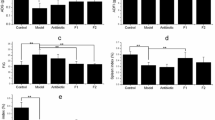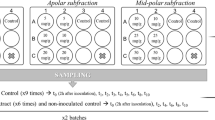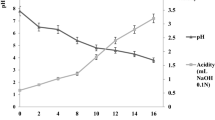Abstract
Currently, different countries’ policies prohibit the use of synthetic antibiotics in animal production. As a consequence, researchers have been looking for sources of these molecules in plants, vegetables, and agro-industrial waste in order to inhibit pathogenic microorganisms, such as Escherichia coli, Salmonella and Listeria and control livestock health. Hydro-alcoholic extracts of the leaves of three different plants- Avocado (Persea americana Mill) Hass variety, guava (Psidium guajava L.) Calvillo variety, and cherry plum (Prunus cerasifera Ehrh) Pissardii variety, at three different ethanol:water ratios (20:80, 50:50, and 80:20 volume/volume) were analyzed. Total phenols in the extracts were quantified by the Folin-Ciocalteu Method and the inhibitory spectrum test against Gram+: Listeria monocytogenes ATCC 19115, Bacillus subtilis ATCC 662, Enterococcus sp., Staphylococcus sp. and Gram−: Escherichia coli ATCC 25922, Salmonella enterica serotipo Enteriditis ATCC 13076, Klebsiella sp. and Pseudomonas sp. using the agar well-diffusion method. The highest phenol content and antioxidant capacity were found in the guava leaf extract at 50:50 (111.7 ± 8.8 EAG mg/mL dry matter, 450 ± 3 μM TE/g dry matter), and this was the only extract that showed total inhibitory spectrum activity for all the microorganisms evaluated among the extracts tested, with a range of 0.62–1.25 mg/mL minimal inhibitory capacity (MIC). A hydroalcoholic extract of guava leaves had strong antimicrobial activity against different pathogenic microorganisms and could be considered as a potential alternative to synthetic antibiotics for use in animal production.
Similar content being viewed by others
References
Akyildiz S, Denli M (2016) Application of plant extracts as feed additives in poultry nutrition. Ser D Anim Sci 59:72–74
Amyrgialaki E, Makris DP, Mauromoustakos A, Kefalas P (2014) Optimization of the extraction of pomegranate (Punica granatum) husk phenolic using water/ethanol solvent systems and response surface methodology. Ind Crops Prod 59:216–222. https://doi.org/10.1016/j.indcrop.2014.05.011
Andrews JM (2001) Determination of minimum inhibitory concentrations. J Antimicrob Chemother 48(suppl. S1):5–16
Arizmendi-Cotero D, Gómez-Espinoza RM, Dublán-García O, Gómez-Vidales V, Domínguez-López A (2016) Electron paramagnetic resonance study of hydrogen peroxide/ascorbic acid ratio as initiator redox pair in the inulin-gallic acid molecular grafting reaction. Carbohydr Polym 136:350–357
Baljett SY, Simmy G, Ritika Y, Roshanlal Y (2015) Antimicrobial activity of individual and combined extracts of selected spices against some pathogenic and food spoilage microorganisms. Food Res Int 22(6):2594–2600
Barrington GM, Gay JM, Evermann JF (2002) Biosecurity for neonatal gastrointestinal diseases. Vet Clin Food Anim 18:7–34. https://doi.org/10.1016/S0749-0720(02)00005-1
Biswas B, Rogers K, McLaughlin F, Daniels D, Yadav A (2013) Antimicrobial activities of leaf extracts of guava (Psidium guajava L.) on two gram-negative and gram-positive bacteria. Int J Microbiol. https://doi.org/10.1155/2013/746165
Camarena-Tello JC, Martínez-Flores HE, Garnica-Romo MG, Padilla-Ramírez JS, Saavedra-Molina A, Alvarez-Cortes O, Bartolomé-Camacho MC, Rodile-López JO (2018) Quantification of phenolic compounds and in vitro radical scavenging abilities with leaf extracts from two varieties of Psidium guajava L. Antioxidants 7(34):1–12. https://doi.org/10.3390/antiox7030034
Chen FF, Sang J, Zhang Y, Sang J (2018) Development of a green two-dimensional HPLC-DAD/ESI-MS method for the determination of anthocyanins from Prunus cerasifera var. atropurpurea leaf and improvement of their stability in energy drinks. Int J Food Sci Technol. https://doi.org/10.1111/ijfs.13730
CLSI Clinical and Laboratory Standar Institute (2012) Performance standards for antimicrobial disk susceptibility tests. Approved standard, 7th edn, document M02-A11, vol 32, no 1. Accessed 22 June 2018
Commission European (2003) Regulation of the European parlament and the council of additives for use in animal nutrition. Off J Eur Union 268:29–43
Díaz-de-Cerio E, Gómez-Caravaca AM, Verardo V, Fernández-Gutiérrez A, Segura-Carretero A (2016) Determination of guava (Psidium guajava L.) leaf phenolic compounds using HPLC-DAD-QTOF-MS. J Funct Foods 22:376–388. https://doi.org/10.1016/j.jff.2016.01.040
Domingo D, López-Brea M (2003) Plantas con acción antimicrobiana. Rev Esp Quimioter 16(4):385–393
Frankič T, Voljč M, Salobir J, Rezar V (2009) Use of herbs and spices and their extracts in animal nutrition. Acta Agric Slov 94(2):95–102
Geetha M, Palanivel KM (2018) A brief review on salmonellosis in poultry. Int J Curr Microbiol Appl Sci 7(05):1269–1274. https://doi.org/10.20546/ijcmas.2018.705.153
Gorinstein M, Leontowicz H, Leontowicz M, Namiesnik J, Najman K, Drzewiecki J, Cvikrová M, Martincová O, Katrich E, Trakhtenberg S (2008) Comparison of the main bioactive compounds and antioxidant activities in garlic and white and red onions after treatment protocols. J Agric Food Chem 56(12):4418–4426. https://doi.org/10.1021/jf800038h
Holtshausen L, Chaves AV, Beauchemin KA, McGinn SM, McAllister TA, Odongo NE, Cheeke PR, Benchaar C (2009) Feeding saponin-containing Yucca schidigera and Quillaja saponaria to decrease enteric methane production in dairy cows. J Dairy Sci 92(6):2809–2821. https://doi.org/10.3168/jds.2008-1843
Kiassos E, Mylonaki S, Makris DP, Kefalas P (2009) Implementation of response surface methodology to optimize extraction of onion (Allium cepa) solid waste phenolics Innovative. Innov Food Sci Emerg Technol 10:246–252
Kittisakulnam S, Saetae D, Suntornsuk W (2017) Antioxidant and antibacterial activities of spices traditionally used in fermented meat products. J Food Process Preserv 41:1–8. https://doi.org/10.1111/jfpp.13004
Li S, Wang P, Yuan W, Su Z, Bullard SH (2016) Endocidal regulation of secondary metabolites in the producing organisms. Sci Rep 6:1–17. https://doi.org/10.1038/srep29315
Lu M, Yuan B, Zeng M, Chen J (2011) Antioxidant capacity and major phenolic com- pounds of spices commonly consumed in China. Food Res Inter 44(2):530–536. https://doi.org/10.1016/j.foodres.2010.10.055
Makkar HPS, Sen S, Blummel M, Becker K (1998) Effects of fractions containing saponins from Yucca schidigera, Quillaja saponaria and Acacia auriculoformis on rumen fermentation. J Agric Food Chem 46:4324–4328. https://doi.org/10.1021/jf980269q
Mantecón T, Ahumada A (2000) Diarrea mecánica de porcino en lactancia y postdestete. Mundo Ganadero, Eumedia. Madrid, España. Febrero 1(119):48–50
Martínez R, Ortega ME, Herrera JG, Kawas JR, Zárate JJ, Robles RS (2015) Uso de aceites esenciales en animales de granja. Interciencia 40(11):744–750
Masschelein-Kleiner L (2004) Les solvants. Dirección de Bibliotecas Archivos y Museos, Centro Nacional de Conservación y Restauración Propiedad Intelectual No. 138.776, ISBN: 956-244-166-0
Mehta S, Soni N, Satpathy G, Gupta RK (2014) Evaluation of nutritional, phytochemical, antioxidant and antibacterial activity of dried plum (Prunus domestica). J Pharmacogn Phytochem Title 3(2):166–171
Nightingale KK, Schukken HY, Nightingale CR, Fortes ED, Ho AJ, Her Z, Grohn YT, McDonough PL, Wiedmann M (2004) Ecology and transmission of Listeria monocytogenes infecting ruminants and in the farm environment. Appl Environ Microbiol 70(8):4458–4467
Oboh G, Odubanjo VO, Bello F, Ademosun AO, Oyeleye SI, Nwanna EE, Ademiluyi AO (2016) Aqueous extracts of avocado pear (Persea americana Mill.) leaves and seeds exhibit anti-cholinesterases and antioxidant activities in vitro. J Basic Clin Physiol Pharmacol 27(2):131–140. https://doi.org/10.1515/jbcpp-2015-0049
Pereira V, Chapel JM, Rodríguez-Bermúdez R, Orjales I, Domínguez R, Vázquez P (2017) Los extractos vegetales son una alternativa natural a los antibióticos. Sitio Argentino de Producción Animal. www.produccion-animal.com.ar. Accessed 15 June 2018
Qian H, Nihorimbere V (2004) Antioxidant power of phytochemicals from Psidium guajava leaf. J Zhejiang Univ Sci 5:676–683
Rasool M, Malik A, Arooj M, Alam MZ, Alam Q, Awan M, Asif M, Qazi MH, Zaheer A, Khan SU, Haque A, Pushparaj PN, Choudhry H, Jamal MS (2017) Evaluation of antimicrobial activity of ethanolic extracts of Azadirachta indica and Psidium guajava against clinically important bacteria at varying pH and temperature. Biomed Res 28:134–139. https://doi.org/10.5812/ajcmi.12987
Robles-García MA, Aguilar AJ, Gutiérrez-Lomelí M, Rodríguez-Félix F, Morales-Del-Río JA, Guerrero-Medina PJ, Madriga-Pulidol JA, Del-Toro-Sánchez CL (2016) Identificación cualitativa de metabolitos secundarios y determinación de la citotoxicidad de extractos de tempisque (Sideroxylum capiri pittier). Biotecnia 17(3):3–8. https://doi.org/10.18633/biotecnia.v18i3.328
Salem AZM, Olivares M, López S, González-Ronquillo M, Rojo R, Camacho LM, Cerrillo SMA, Mejia HP (2011) Effect of natural extracts of Salix babylonica and Leucaena leucocephala on nutrient digestibility and growth performance of lambs. Anim Feed Sci Technol 170:27–34. https://doi.org/10.1016/j.anifeedsci.2011.08.002
Smith TC (2015) Livestock-associated Staphylococcus aureus: the United States experience. PLoS Pathog 11(2):1–8. https://doi.org/10.1371/journal.ppat.1004564
Soto-García M, Rosales-Castro M (2016) Effect of solvent and solvent-to-solid ratio on the phenolic extraction and the antioxidant capacity of extracts from Pinus durangensis and Quercus sideroxy la BARK. Maderas Cienc Tecnol 18(4):701–714. https://doi.org/10.4067/S0718-221X2016005000061
Spizzirri UG, Iemma F, Puoci F, Cirillo G, Curcio M, Parisi OL, Picci N (2009) Synthesis of antioxidant polymers by grafting of gallic acid and catechin on gelatin. Biomacromol 10:1923–1930. https://doi.org/10.1021/bm900325t
Tajkarimi MM, Ibrahim SA, Cliver DO (2010) Antimicrobial herb and spice compounds in food. Food Control 21:1199–1218. https://doi.org/10.1016/j.foodcont.2010.02.003
Yamassaki FT, Campestrini LH, Zawadzki-Baggio SF, Maurer JBB (2017) Avocado leaves: influence of drying process, thermal incubation, and storage conditions on preservation of polyphenolic compounds and antioxidant activity. Int J Food Prop 20(S2):S2280–S2293. https://doi.org/10.1080/10942912.2017.1369105
Acknowledgements
Authors would like to thank the Consejo Nacional de Ciencia y Tecnología (CONACYT) for providing a scholarship to the main author. Thanks to the Facultad de Ciencias Agrícolas at the Universidad Autónoma del Estado de México, Estado de México, México for Access to laboratories to carry out the study and to the Unidad de Investigación y Desarrollo en Alimentos (UNIDA) of the Instituto Tecnológico de Veracruz, Veracruz, México for access to the microbial strains and microbiology laboratory.
Author information
Authors and Affiliations
Corresponding author
Ethics declarations
Conflict of interest
The authors declare that they have no conflicts of interest.
Additional information
Publisher's Note
Springer Nature remains neutral with regard to jurisdictional claims in published maps and institutional affiliations.
Rights and permissions
About this article
Cite this article
Archundia Velarde, E.D., Pinzón Martínez, D.L., Salem, A.Z.M. et al. Antioxidant and antimicrobial capacity of three agroindustrial residues as animal feeds. Agroforest Syst 94, 1393–1402 (2020). https://doi.org/10.1007/s10457-018-00343-7
Received:
Accepted:
Published:
Issue Date:
DOI: https://doi.org/10.1007/s10457-018-00343-7




